Three Cornered Leek - Invasion Of The Pickled Onions
By Mike on Saturday, May 3, 2014, 15:36 - Permalink
May 2014 - I have the dubious convenience of having an inexhaustible supply of a wild onion species - Three-Cornered Leek - right on my doorstep.
In fact, it's in my garden - it's everywhere in my garden. This beautiful, but invasive plant wants to take over.
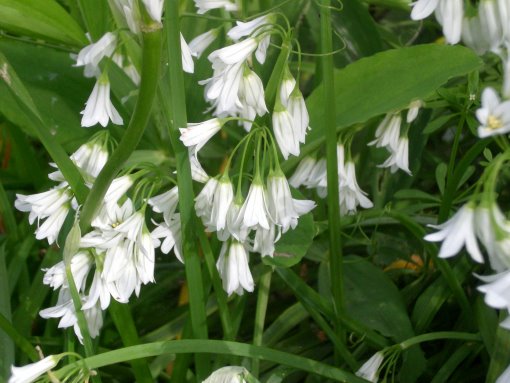
What Is Three-Cornered Leek?
Allium triquetrum - also known as Onionweed, Triquetrous Garlic or Three-Cornered Garlic, this member of the onion family produces upright bright green stems and leaves, about 30cm tall, with flower heads of about 8, drooping white bell-shaped flowers.
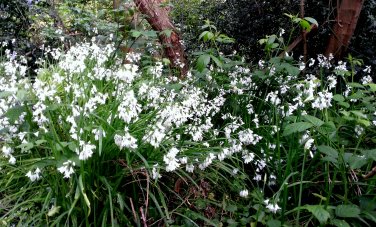 In its proper context - river banks and shady woodland - this plant forms carpets of nodding white flowers - and in places like this, where the soil is of only average fertility and nutrient, it behaves no better or worse than many a forest floor herb.
In its proper context - river banks and shady woodland - this plant forms carpets of nodding white flowers - and in places like this, where the soil is of only average fertility and nutrient, it behaves no better or worse than many a forest floor herb.
The pendulous, swaying white flowers are similar to the white form of English bluebells - alongside which it is often found growing.
 There's no denying that the flowers themselves are very pretty - the delicate, translucent white petals have a neat central green stripe on them - and the flowers provide a copious nectar source for bees.
There's no denying that the flowers themselves are very pretty - the delicate, translucent white petals have a neat central green stripe on them - and the flowers provide a copious nectar source for bees.
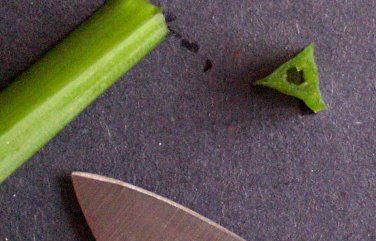 A cross-section of the stem illustrates how this plant got its name - the flower stems are concave-triangular in shape - the leaf blades too, have a keel ridge underneath (which gives them the rigidity to stand upright) - so they too are roughly triangular in section.
A cross-section of the stem illustrates how this plant got its name - the flower stems are concave-triangular in shape - the leaf blades too, have a keel ridge underneath (which gives them the rigidity to stand upright) - so they too are roughly triangular in section.
 Every part of the plant is edible - the leaves have an onion-garlic flavour approximately similar to spring onions and the plant produces lots of small white bulbs underground.
Every part of the plant is edible - the leaves have an onion-garlic flavour approximately similar to spring onions and the plant produces lots of small white bulbs underground.
It's probably best to use either the bulbs or leaves on their own - rather than trying to slice up whole plants in the manner of preparing leeks or spring onions, as the loose structure of the lower stems does tend to trap a great deal of soil.
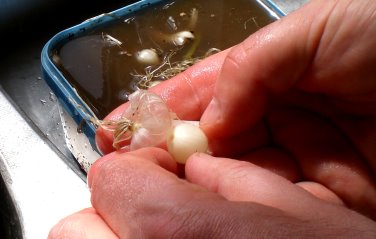 The bulbs can be separated out just by rinsing off the soil (I placed the harvested bulbs and roots in a container of cold water to soak), then squeezing them by hand.
The bulbs can be separated out just by rinsing off the soil (I placed the harvested bulbs and roots in a container of cold water to soak), then squeezing them by hand.
The outer layers of stem and leaf will split and the small, hard white bulbs inside will just pop out cleanly.
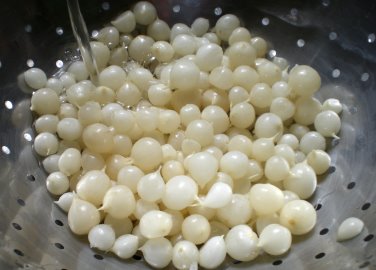 The collected bulbs look a lot like small 'silverskin' onions - they are hard and crisp and I think they would pickle well.
The collected bulbs look a lot like small 'silverskin' onions - they are hard and crisp and I think they would pickle well.
So that's exactly what I intend to do with these - pickle them.
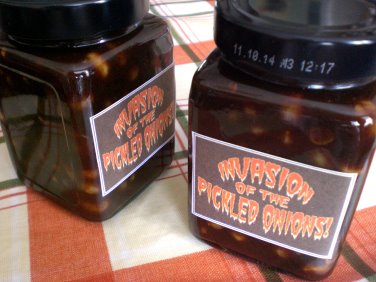 I pickled a couple of jars of the onion bulbs in a spiced chutney recipe - with apples, prunes and dark brown sugar - (the pickling process is detailed in the video below).
I pickled a couple of jars of the onion bulbs in a spiced chutney recipe - with apples, prunes and dark brown sugar - (the pickling process is detailed in the video below).
Unfortunately, I now have to wait a couple of months for the chutney to mature before I can taste it. I'll try to remember to update this page with the results of tasting...
Eradication
I don't know exactly how this plant arrived in my garden, but it does unfortunately have to go - it's just too vigorous and in the space of two or three summers, has gone from being one solitary stalk, to vast mats of stems and leaves, choking out many other plants.
In fact, I'm just astounded at the sheer volume of vegetable matter we have had to remove when digging it out - at the time of writing this page, we must have taken half a ton of onions to the civic amenities site (where it will be hauled off for high temperature composting, which will destroy the seeds and bulbs).
So unless you have an enormous country garden (of the sort where you often say things like "I think I saw deer in the western copse this morning"), don't even think about introducing this plant to it. And if you gather any as a wild food, don't compost any trimmings in case they include viable seeds or pieces of bulb.
Note
Before, during or after the video(s) embedded in this page, the player may display advertisements or links to additional videos - these are not affiliated to Atomic Shrimp and the selection is something over which I have no control.
